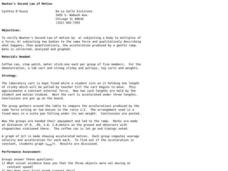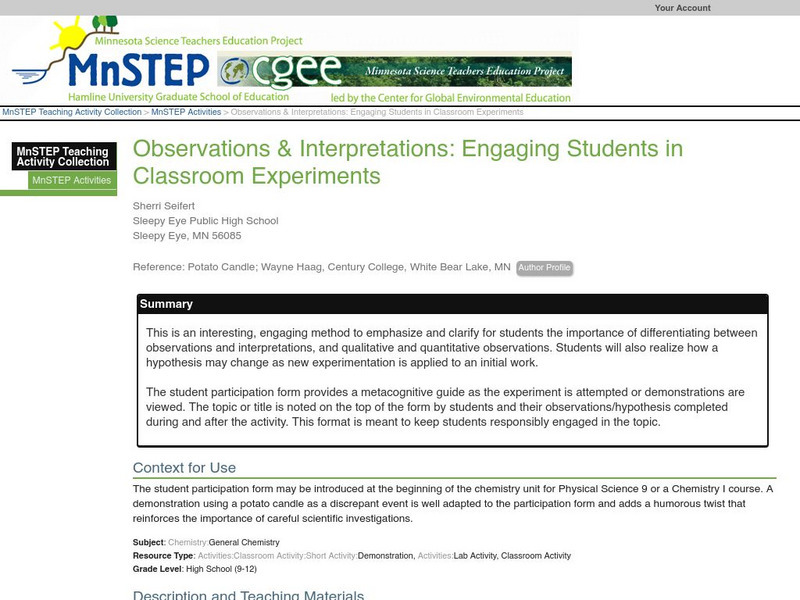Curated OER
Photosynthesis and Respiration
Eighth graders differentiate photosynthesis and respiration. In this biology lesson, 8th graders draw a diagram explaining these two processes. They answer a quiz after the lesson.
Curated OER
Nature of Meteor Showers
Ninth graders describe, in general terms, the distribution of matter in space and
identify evidence for, and describe characteristics of, bodies that make up the solar system. They then investigate predictions about the motion,...
Curated OER
Cycles Review
Eighth graders discuss the four major cycles of matter. In this general science lesson, 8th graders decide which of the four is the most important. They share their opinion in class.
Curated OER
Introduction to Ecology
Eighth graders identify the living and nonliving components of an ecosystem. In this ecology instructional activity, 8th graders explain the role each organism plays. They participate in class discussion and answer a quiz at the end...
Curated OER
Introduction to Biomes
Eighth graders identify the different kinds of biomes. In this life science lesson, 8th graders explain their importance in an ecosystem. They take a BrainPop quiz at the end of the lesson..
Curated OER
Ecology: Adaptations
Eighth graders identify different types of adaptation in organisms. In this biology instructional activity, 8th graders explain how adaptation help organisms survive. They complete a worksheet at the end of the instructional activity.
Curated OER
I'm Inclined to See; Physics, Math, Science, Experiments, Graphs
Young scholars discover the motion of a sphere on an inclined plane and discover basic relationships involving distance, time, speed(velocity), and acceleration.
Curated OER
I'm Inclined to See
Pupils examine motion of a sphere on an inclined plane. In this inclined plane lesson students complete an activity to discover basic relationships.
Curated OER
Newton's Second Law of Motion
Sixth graders study Newton's second law of motion and verify it. In this force and motion lesson students complete a lab activity and collect data, analyze it and graph it.
Curated OER
Electroplating for Corrosion Protection: Redox in Action
Students define what a redox reaction is. In this chemistry lesson, students electroplate some wires in the lab. They research the application of electroplating in the real world.
Curated OER
Revised “Understanding Nutrition” Activity
Students evaluate their current food choices. In this health science lesson, students test different drinks to rate the amount of Vitamin C content. They discuss results in class.
Curated OER
Plants in Texas: Then and Now
Seventh graders discuss continuity and change, identify various plant materials, and compare and contrast ways in which early people used plants in Texas in prehistoric times with ways that modern man in Texas uses plants today.
Quizlet
Quizlet: Making Observations and Inferences Test
A test with four multiple choice questions over inferencing, quantitative observation, and qualitative observation.
Dartmouth College
Dartmouth College: Qualitative Analysis of Anions
"In this experiment, you will observe the reactions of some simple salts, analyze common household chemicals, and identify an unknown sample by testing its reactivity."
Science Education Resource Center at Carleton College
Serc: Chemical Changes: Reacting an Acid and Base
In this chemistry lab, students will investigate chemical changes that occur when acids and bases react. It is meant to introduce the concepts of chemical changes, gases have mass, conservation of mass, and balancing equations. Students...
Science Education Resource Center at Carleton College
Serc: Observations & Interpretations: Engaging Students in Classroom Experiments
Use this method to emphasize and clarify for students the importance of differentiating between observations and interpretations, and qualitative and quantitative observations. Students will learn how a hypothesis may change as new...
Sophia Learning
Sophia: Qualitative and Quantitative Observations: Lesson 1
This lesson will explain the difference between qualitative and quantitative data. It is 1 of 4 in the series titled "Qualitative and Quantitative Observations."
Sophia Learning
Sophia: Qualitative and Quantitative Observations: Lesson 4
This lesson will explain the difference between qualitative and quantitative data. It is 4 of 4 in the series titled "Qualitative and Quantitative Observations."
Sophia Learning
Sophia: Qualitative and Quantitative Observations: Lesson 3
This lesson will explain the difference between qualitative and quantitative data. It is 3 of 4 in the series titled "Qualitative and Quantitative Observations."
Science Struck
Science Struck: Qualitative and Quantitative Observations
Explains what qualitative and quantitative observations are and what they look like in science. Includes examples that highlight their differences.
TeachEngineering
Teach Engineering: Don't Confuse Your Qs!
Students investigate the difference between qualitative and quantitative measurements and observations. By describing objects both qualitatively and quantitatively, they learn that both types of information are required for complete...
Other
Science4 Us: Science Tools
The Tools module introduces students to the tools scientists use for both qualitative and quantitative observations. Students learn to use tools such as their senses, rulers, and balance scales through hands-on activities.
Texas Instruments
Texas Instruments: Forensics Case 7 Drug Tests: Identifying an Unknown Chemical
In this activity, students distinguish between physical and chemical properties. They also understand the differences between qualitative and quantitative observations. They use quantitative and qualitative analyses to identify an...
The Tech Interactive
The Tech Interactive: Tech Tip: Data Collection: Reflecting on Your Design [Pdf]
This resource explains why data collection is a great way to make informed improvements to a design, and how to do it. Data can be quantitative - such as a measurement of distance or time - or qualitative, such as an observation of...




















